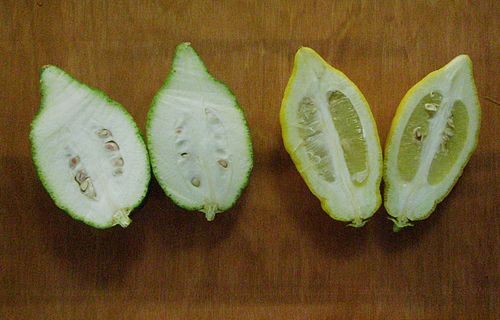
TheYemenite citron (Hebrew:אֶתְרוֹג תֵּימָנִי,etrog teimani)[a] is avariety ofcitron, usually containing nojuice vesicles in its fruit'ssegments. The bearing tree and the mature fruit's size are somewhat larger than the trees and fruit of other varieties of citron.[1][2]
| Citronvarieties |
|---|
 |
| Acidic-pulp varieties |
| Non-acidic varieties |
| Pulpless varieties |
| Citronhybrids |
| Related articles |
Despite its major differences from standard varieties of the most common original citron, the Yemenite citron was attested by a group of citrus and genetic experts to be a true variety of citron, and possesses a closegenetic relation with the rest of the types. A brief documentation of this study was presented at the Global Citrus Germplasm Network.[3]
The Yemenite kind is highly affiliated with theMoroccan citron which is traditionally cultivated in a remote area in the absence of any other citrus species.[4]

Although other varieties ofpulpless citron, such asBuddha's hand, can be found inIndia andChina,[5] mostJewish cultures are not aware of them, therefore the Yemenite citron is the only pulpless citron used asetrog. According to theYemenite tradition that is claimed to trace back tothe first Temple, their kind was with them all the times.

Etrog haCushi (Hebrew:אֶתְּרוֹג הַכּוּשִׁי) is mentioned in theMishnah as well as in both theBabylonian (Succa 36a) and theJerusalem Talmud (Succa 3:6). The most common interpretation is that theBiblical Cush refers toEthiopia,[6] and thereforeEtrog haKuschi should also refer to something which could be called theEthiopian citron.
TheEthiopian Jews did not follow themitzva offour species, even though they did anticipate theSukkot festival, as well as the rest of theJewish ethnic divisions. This may have been due to their lack of ability to procure the species. Some believe that this is due to someKaraite influence, whose biblical interpretation indicates that the four species are only used as roofing for asukkah (theS'chach), and not for a separate waving ritual.[7]
However, theYemenite citron is available in Ethiopia and its markets, where it is sold for consumption.[8] According to Erich Isaac, the late researcher of citrus distribution, the Yemenite citron is synonymous with the Ethiopian citron, as a result of Ethiopian rule of Yemen in the past.[9][10]
Alternatively, the "etrog haCushi" is understood by some simply as a citron with a very dark coloration. As such the 'Ethiopian etrog' is not an Etrog that comes from Ethiopia but rather an Etrog that is similar in color to the skin of the inhabitants of Ethiopia.[11] This is the explanation given by Rashi (Succa 34a) and would explain why Yemenite citrons are and have always been traditionally used as an etrog even though the Mishna rules that an etrog haCushi cannot be used to fulfill the mitzva.
Growing un-grafted citrons inYemen has some associated difficulties, particularly since citron is a highly susceptible plant.[vague]
The most common rootstock types that are currently used to graft citrus in Yemen areSour orange (Citrus × aurantium) andRough lemon (Citrus jhambiri),[12] which are very helpful to prevent exocortis in Northern Yemen. The specific rootstock species are not carefully documented in Yemen and therefore difficult to detect, after the graft is done. However, throughout Yemen,grafting is not enough to prevent infection byPhytophthora gummosis, which can nonetheless still be controlled by appropriate horticultural practices.[13]
The main cultivation area of the Yemenite citron today isIsrael, where it is highly sought out for its beauty and large size.[citation needed]